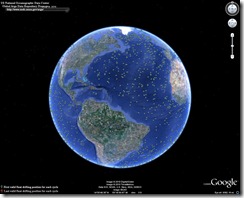Last week we had just received the UD-134 glider (aka the “Blue Hen”) from two tours of duty in the Gulf of Mexico in collaboration with IOOS and Rutgers University for the Deepwater Horizon Oil Spill Response project. To prepare for an upcoming Antarctic mission, we needed to get some work done on UD-134 at the source – Teledyne Webb Research in Massachusetts. Since we were only five hours south of Webb at the time, I loaded the Zune HD (with purely educational podcasts of course – in this case Security Now) and it was road-trip time for me and two of the students from the ORB lab.
The students who went with were really excited to get to learn from the masters while we tore down UD-134 at Rutgers. (For those new to gliders, Rutgers is the undisputed kings of the glider realm, they’ve been flying them since, like forever). One of the students who came with was a summer intern who was charged with learning how to pilot the Glider over the summer. Because of the last-minute deployment of UD-134 in the Gulf, he had lots of pilotting time on a simulator, but not so much hands-on with real Gliders. The other student was a new grad student who would be responsible for ingesting and processing glider data, so she was looking forward to the trip as well. When we decided at the last minute to head up to Webb Research to deliver the components, the intern said he “felt like Willie Wonka with the winning ticket to tour the chocolate factory”. He was definitely not disappointed as Peter Collins met us at the doors of Webb and gave the students and I the grand tour.
Peter Collins (aka “Texas Pete” for this post) donned his cowboy hard hat and headed to the ballast tank with me and a couple of our students last week to do a quick talk for Ocean Bytes. Pete gave a quick introduction to the Slocum Electric Glider – an Autonomous Underwater Vehicle (AUV) or Underwater Glider that is made by Teledyne Webb Research. Take note that the glider that Pete has in front of him as it is a tad different from most in that it has two science bays (there is usually only one). This one is being fitted with a Photosynthetically Active Radiation (PAR) sensor and a FIRe sensor (remember Lauren’s video?) from Satlantic. I’ll hand you to Peter now so he can discuss what a glider is for and how it works…
In addition to the lineup of first generation gliders, we were introduced to the second generation gliders that are just now being manufactured – also called the “G2” gliders. I’ll try to cover everything that we learned about the G2 systems in a future post.
Thanks again Peter for the awesome hospitality and for taking such great care of us!
Note: Getting lots of inquiries as to where one might obtain “Cowboy Hard Hats” – Peter provided a couple of links to possible suppliers – Link 1 and Link 2.

